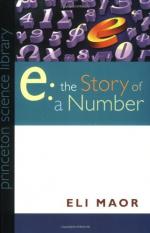|
This section contains 344 words (approx. 2 pages at 300 words per page) |
The number e, like the number pi, is a useful mathematical constant that is the basis of the system of natural logarithms. Its value correct to nine places is 2.718281828... The number e is used in complex equations to describe a process of growth or decay. It is therefore utilized in the biology, business, demographics, physics, and engineering fields.
The number e is widely used as the base in the exponential function y = Cekx. There are extensive tables for ex, and scientific calculators usually include an ex key. In calculus one finds that the slope of the graph of ex at any point is equal to ex itself, and that the integral of ex is also ex plus a constant.
Exponential functions based on e are also closely related to sines, cosines, hyperbolic sines, and hyperbolic cosines: eix = cos x + isin x; and ex = cosh x + sinh x. Here I is the imaginary number -1. From the first of these relationships one can obtain the curious equation ei + 1 = 0, which combines five of the most important constants in mathematics.
The constant e appears in many other formulae in statistics, science, and elsewhere. It is the base for natural (as opposed to common) logarithms. That is, if ex = y, then x = ln y. (ln x is the symbol for the natural logarithm of x.) ln x and ex are therefore inverse functions.
The expression (1 + 1/n)n approaches the number e more and more closely as n is replaced with larger and larger values. For example, when n is replaced in turn with the values 1, 10, 100, and 1000, the expression takes on the values 2, 2.59..., 2.70..., and 2.717....
Calculating a decimal approximation for e by means of the this definition requires one to use very large values of n, and the equations can become quite complex. A much easier way is to use the Maclaurin series for ex: ex = 1 + x/1! +x2/2! + x3/3! + x4/4! +.... By letting x equal 1 in this series one gets e = 1 + 1/1 + 1/2 + 1/6 + 1/24 + 1/120 +.... The first seven terms will yield a three-place approximation; the first twelve will yield nine places.
|
This section contains 344 words (approx. 2 pages at 300 words per page) |


